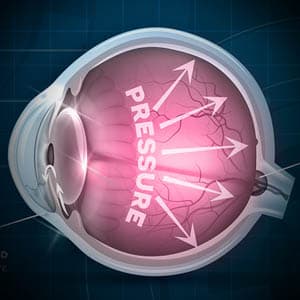Glaucoma is the #1 preventable cause of vision loss.
What is glaucoma?
Glaucoma is an eye disease that causes vision loss from damage to the optic nerve, which is responsible for carrying visual signals between the eye and brain.
- Glaucoma is the #1 cause of irreversible blindness, worldwide.
- Glaucoma accounts for 12.3% of global blindness.
- Glaucoma affects up to 5% of the people aged 70+ years and increases to over 9% for those aged 80+ years.
The most common form of glaucoma occurs when there is high pressure inside the eye (intraocular pressure, IOP), caused by a build-up of fluid that cannot drain properly.
Glaucoma: the ‘Silent Thief of Sight’
This nickname is well deserved as glaucoma causes vision loss before most people notice any symptoms.
Glaucoma has the infamous reputation of “robbing” eyesight, without giving the person time to recognize symptoms and seek their eye doctor’s medical opinion.
Consequently, a diagnosis of glaucoma is too often made too late, and only after permanent vision loss has occurred.
It is therefore important to schedule regular eye exams, as new diagnostic tests are available to detect early signs of glaucoma, and are essential in preventing vision loss.
What is narrow-angle glaucoma (NAG)?
Narrow-angle glaucoma is a type of glaucoma that develops suddenly and can lead to sudden and permanent loss of sight.
Narrow-angle glaucoma is the cause of less than 10% of all glaucoma diagnosis, but can cause immense pain and sudden loss of sight and even blindness.
This condition is also known as ‘acute angle-closure glaucoma’ or ‘closed-angle glaucoma’ and occurs when the drainage angle, a structure inside the eye that permits fluid to drain normally from the eye, becomes blocked.
The resulting fluid buildup can cause an abrupt, severe increase in intraocular pressure (IOP) that may result in immediate damage to the optic nerve.
SEE RELATED: What is Glaucoma?
Contact an eye doctor near you if you have any concerns about your vision or eye health
Types of narrow-angle glaucoma
There are two forms of narrow-angle glaucoma: acute and chronic.
1. Acute NAG
Acute NAG is a term that refers to the sudden closing of the drainage angle. When the usual passage of aqueous humor between the iris and the lens is suddenly and immediately interrupted, this form of glaucoma develops.
2. Chronic NAG
Chronic NAG is also due to a narrowed drainage angle, but this form develops slowly and can cause damage gradually over a period of time, often without obvious symptoms.
Symptoms of narrow-angle glaucoma
Most people will experience the following symptoms since their eye pressure rises dramatically in a short period of time:
- Nausea
- Eye pain
- Red eyes
- Headache
- Blurred vision
- Mid-dilated pupil
- Halos around lights
- Sudden loss of vision
- Sudden severe eye and head pain
LEARN MORE: Guide to Eye Conditions
Schedule an eye exam with an eye doctor near you who can diagnose if you have narrow-angle glaucoma.
It’s easy to become concerned when you learn about narrow-angle glaucoma’s fast onset and serious consequences.
Fortunately, a comprehensive eye exam can diagnose the condition, and it can be treated with a range of successful treatments. The sooner any type of glaucoma is diagnosed and treated, the lower the risks of vision loss.










